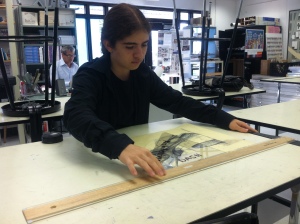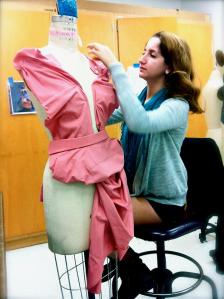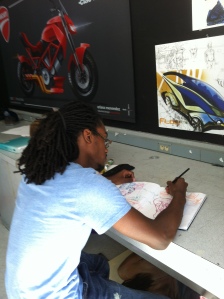DASH Dispatch: In terms of workload and time management, what are the main differences between what you knew about your strand before you started versus now?
Daniel Villegas: After a lot of waiting through freshman year, I finally entered the Architecture program with high expectations. It was the class I had yearned for most, and come sophomore year, it was finally here. My expectations ran high, and all of them were met and surpassed. One of these expectations was the addition to my workload. Not until you do something yourself can you fully understand the quantity of work that goes into the process. This holds true with architecture, and becomes evident early on in the class. For every final drawing you see, there are many preliminary drafts that came before it, and those drafts usually involve countless sketches and hours of research. It might sound tedious, but for me the entire process is enjoyable and rewarding.
DD: What strategies or changes to your routine have helped you manage your workload?
DV: In order to accommodate my increased workload, I began to use the times that I would not traditionally utilize for work. I have found that working consistently in discreet portions every day, instead of attempting the bulk of the work in large spans of time, works well for me. Really, the important thing is to know yourself, how and when you work best, and then arrange your schedule to achieve the greatest efficiency. Planning ahead, I use my commute on the metro train and bus to study for upcoming tests. I find it important, however, to begin studying long before the exam, reviewing the material a little more each day instead of cramming all at once right before the exam.
DD: How do you get your work done outside of DASH when you don’t have access to the resources at school (i.e. software, sewing machines, etc.)?
DV: I typically try to have everything I need wherever I work, but sometimes, especially with computer software, the tool is not available at home. What I tend to do in that case is to make time so that, while in school, I may work additional time. With permission from my teachers, I might work during lunch and class, focusing on the section of work that I know I do not have the resources to complete at home. Another alternative I have used is to go to the home of a friend whom I know has the software or tool.
DD: In what ways have your classmates, family, or friends become a support system?
DV: As mentioned above, I have used my friends’ tools to help get my work done. At the same time, I have placed my own resources at their disposition, creating a network based on camaraderie for everyone’s mutual benefit. This network goes past lending your circle template to someone else. Sometimes it comes in handy to talk to a fellow student when you are not sure what the teacher expects. When different vantage points are coalesced, then a more encompassing view of the world around us may be realized. Though it may seem overly philosophical, the previous statement can be applied to almost anything, from discussions to trying to figure out the information that is supposed to be presented in the next site analysis drawing.
DD: What do you do to balance school work with time for rest, social activities, a job, etc.?
DV: I organize my schedule so that I finish the assignments I least look forward to first, leaving Architecture, something I find truly enjoyable, last as a form of relaxation and reward. I also tend to use times that are usually wasted to get ahead, and thereby create time that may be used for social activities after my school work is done. This is beneficial because it means I will not be forced to cram if I go over the time I allotted myself for relaxation, and I may rest or spend time with friends without the constant worry of the upcoming assignment that I still have to finish.





 Ilana Ladis,
Ilana Ladis,